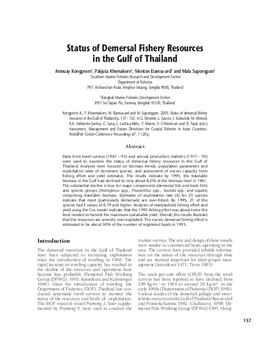Status of demersal fishery resources in the Gulf of Thailand
Abstract
Data from trawl surveys (1961 - 95) and annual production statistics (1971 - 95) were used to examine the status of demersal fishery resources in the Gulf of Thailand. Analyses were focused on biomass trends, population parameters and exploitation rates of dominant species, and assessment of excess capacity from fishing effort and yield estimates. The results indicate by 1995, the trawlable biomass in the Gulf had declined to only about 8.2% of the biomass level in 1961. The substantial decline is true for major components (demersal fish and trash fish) and species groups (Nemipterus spp., Priacanthus spp., Saurida spp. and squids) comprising trawlable biomass. Estimates of exploitation rate (E) for 23 species indicate that most (particularly demersals) are over-fished. By 1995, 21 of the species had E values of 0.79 and higher. Analyses of standardized fishing effort and yield using the Fox model indicate that the 1995 fishing effort was about twice the level needed to harvest the maximum sustainable yield. Overall, the results illustrate that the resources are severely over-exploited. The excess demersal fishing effort is estimated to be about 50% of the number of registered boats in 1995

